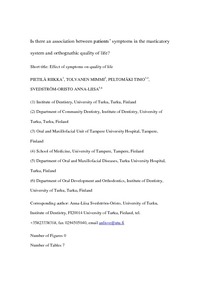Is there association between patients’ symptoms from the masticatory system and orthognatic quality of life?
Pietilä, Riikka (2017-09-18)
Is there association between patients’ symptoms from the masticatory system and orthognatic quality of life?
Pietilä, Riikka
(18.09.2017)
Turun yliopisto
Julkaisu on tekijänoikeussäännösten alainen. Teosta voi lukea ja tulostaa henkilökohtaista käyttöä varten. Käyttö kaupallisiin tarkoituksiin on kielletty.
avoin
Julkaisun pysyvä osoite on:
https://urn.fi/URN:NBN:fi-fe201709188643
https://urn.fi/URN:NBN:fi-fe201709188643
Tiivistelmä
Objective. The aim of this study was to investigate the impact of orthognathic patients’ self-reported symptoms from the head and neck region on their orthognathic quality of life (OQOL) and satisfaction with occlusal function. Subjects and methods. Participants included consecutive patients (n=50) referred to assessment of orthognatic treatment need and voluntary first-year university students (n=29). All participants filled in the Orthognathic Quality of Life Questionnaire (OQOL) and a structured diary made by the authors. The mean values of OQOL sum score, satisfaction and number of awakenings were compared between patients and controls. Further, correlations between the mean values of the OQOL sum and subscores, satisfaction with occlusal function and number of awakenings were analyzed. Results. Patients reported more symptoms and woke up significantly more often than controls (p=0.029). Their OQOL sum scores were significantly higher (indicating a lower OQOL) (p=0.001) and they were significantly less satisfied with the occlusal function than controls (p=0.001). Those reporting symptoms, had a statistically significant association between the number of awakenings and satisfaction with occlusal function (p=0.003 and p<0.001, respectively). Among the wakended and not-rested patients, the most commonly reported symptoms were pain in the head and/or neck region and fatique and/or stiffness of the jaws. Conclusions. Experienced pain and discomfort have a significant impact on patients’ OQOL, satisfaction with occlusal function and well-being.
